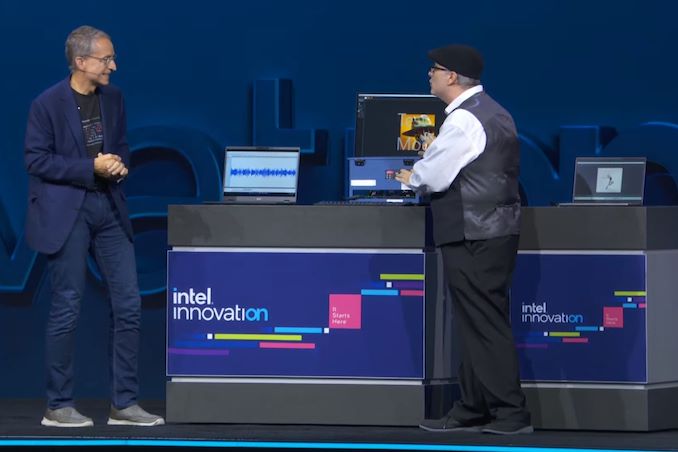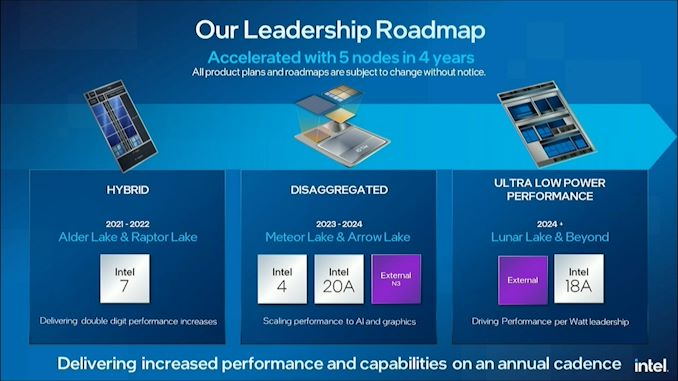Intel Demos Lunar Lake Client Processor In Action, Silicon Pulled In To Intel 20A?
by Ryan Smith on September 19, 2023 3:45 PM EST- Posted in
- CPUs
- Intel
- SoCs
- Intel 20A
- Intel 18A
- Lunar Lake
- Intel Innovation 2023

As part of Intel’s Innovation 2023 conference, the company is not only showing off their current and soon-to-be-current products like Meteor Lake, but the forward-looking keynote by CEO Pat Gelsinger was also used to showcase future generations of Intel products. Perhaps the biggest surprise this year being Intel’s Lunar Lake platform, which is already up and running to the point where Intel can do demos on it.
Lunar Lake is Intel’s 2025 client platform, which is scheduled to arrive after Meteor Lake (very late 2023) and Arrow Lake (2024). At last disclosure from Intel, it is going to be a brand-new platform, replacing the shared Meteor/Arrow platform. At this point, confirmed details are few and far between, other than that it will be bigger and better than Meteor Lake.
| Intel Client Processor Roadmap | ||||
| Name | P-Core uArch | E-Core uArch | Process Node (Compute Tile) |
Release Year |
| Meteor Lake | Redwood Cove | Crestmont | Intel 4 | 2023 (December) |
| Arrow Lake | Lion Cove? | Crestmont? | Intel 20A | 2024 |
| Lunar Lake | Lion Cove? | Skymont? | Intel 20A? | 2024? |
| Panther Lake | ? | ? | Intel 18A | 2025 |
In any case, as part of this year’s Innovation keynote, Gelsinger & co ran a pair of AI demos on their Lunar Lake test box. The first was Riffusion, an AI music generation plugin for Audacity that can generate music based on the style of another artist. The second demo was the now classic Stable Diffusion text-to-image generation model. Both demos were able to leverage the chip’s NPU, which is a new processing block for Intel client chips starting with the impending Meteor Lake.
And while the demo was brief, it served its purpose: to show that Lunar Lake was back from the fab, and was already in good enough shape not just to boot and OS, but to show off controlled demos. Intel has made it clear over the past few years that they intend to move fast to make up for lost time and recapture leadership of the client market (both in terms of architecture and fabs), so they are eager to show off their progress here.
Perhaps the most interesting thing about the demo was what wasn’t said, however: the process node used for Lunar Lake’s compute (CPU) tile. In Intel’s earliest (and still most recent) public roadmap, Lunar Lake was listed to be built on the Intel 18A process. However, other disclosures from Intel today indicate that they’re only going to be starting risk production of 18A silicon in Q1’2024. Which means that for Lunar Lake to be working today, it can’t be on 18A.

Old Intel Client Roadmap, Circa 2022
That leaves 20A as by far the most likely alternative, which is due sooner and is already turning out working wafers. Which means that Intel is planning on using 20A over two generations of client processors: Arrow Lake and Lunar Lake. We’re still waiting on confirmation of this, of course, but all signs currently point to Lunar Lake having shifted to 20A since Intel’s previous update.










9 Comments
View All Comments
Khato - Tuesday, September 19, 2023 - link
Don't the previous roadmaps such as that provided in the article show both "External" and "Intel 18A" as options for Lunar Lake & Beyond? Who's to say that Lunar Lake isn't entirely in the "External" category?ydeer - Wednesday, September 20, 2023 - link
Exactly, I'm surprised the article doesn't even entertain the idea of that being pure TSMC silicon shown on the stage yesterday, which some might say would be a masterclass in product roadmap deception.my_wing - Thursday, September 21, 2023 - link
Because it is not.Because Pat already show am 18A wafer. Where is TSMC wafer????? Where is TSMC N3E wafer ????
So honestly, that is intel baked chip not from TSMC.
brucethemoose - Wednesday, September 20, 2023 - link
Riffusion is, at its core, Stable Diffusion finetuned to generate spectrograms. That is really cool, but Intel is "double dipping" here, essentially showing off the same model architecture twice.Not that its anything to sneeze at, as Riffusion is quite a complex pipe!
edzieba - Wednesday, September 20, 2023 - link
"However, other disclosures from Intel today indicate that they’re only going to be starting risk production of 18A silicon in Q1’2024. Which means that for Lunar Lake to be working today, it can’t be on 18A."Intel will be fabbing test dies long before they even enter risk production. If they ended up with a 'golden sample' that worked far better than they were expecting, I could see them flexing by showing it off in an integrated system.
NextGen_Gamer - Wednesday, September 20, 2023 - link
I was sorta thinking the same thing: risk production obviously isn't mass production, but it is more than a few chips, so yeah, Intel is probably already doing test wafers and maybe got a few dies back that just happened to be super good and stable hahaRyan Smith - Wednesday, September 20, 2023 - link
While I didn't attach it to this article (so that it wasn't overflowing with images), there is another slide where Intel indicates the first 18A design to go to the fab won't be until Q1'24.https://images.anandtech.com/doci/20060/6023140.jp...
NextGen_Gamer - Thursday, September 21, 2023 - link
@Ryan Smith: that slide definitely is important to show, because yeah, it doesn't say early risk production but the actual first silicon at all won't be going to the 18A fabs until 2024. That would mean "Lunar Lake" is definitely Intel 20A now. Thank you for sharing!my_wing - Thursday, September 21, 2023 - link
In my understanding same as Intel 4/3 Intel 20A/18A is High performance/High Density node. The design library is not that much different to one another, or 18A is just a completed set of library vs a custom internal node.What is more worrying me is that Intel going back to sail pace node advancement, no CFET discussed, just blank, as rumors now TSMC N2 is hitting delay, then that means that TSMC N2 will be on ASML High NA, since Intel will received High NA in December 2023, then if by Jan 2024 TSMC received a High NA machine, this will meant that 1 year for TSMC to produce N2.
If TSMC really delay (common after Chang left) then the only positive news is that TSMC N2 is going to produce in High NA (which might not required double patterning.
But the bad news is that Apple will not be slow down, they will not let intel have 2 years advantage and will move to Intel Foundry, there are rumor as well that TSMC slow down the fab build for 2nm, if that is true that Apple left therefore low demand for TSMC N2 then, we might see Intel Sail Pace again, which is not that great.